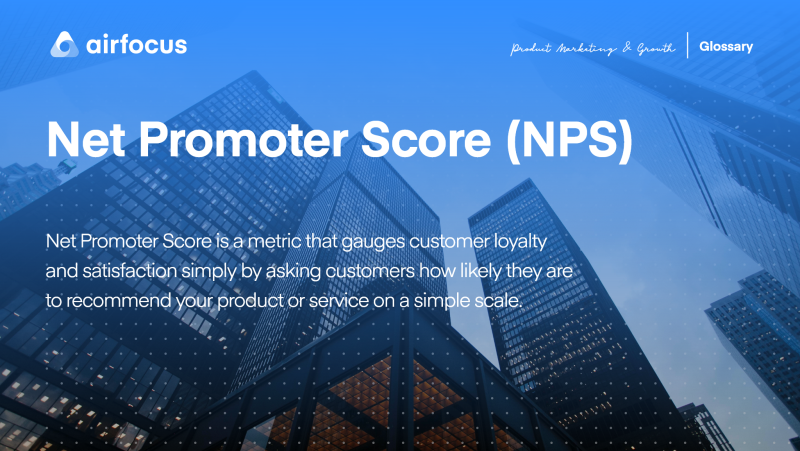Net Promoter Score (NPS)
What is Net Promoter Score (NPS)?
Definition of Net Promoter Score (NPS)
Net Promoter Score is a metric that gauges customer loyalty and satisfaction simply by asking customers how likely they are to recommend your product or service on a simple scale.
Essentially, the Net Promoter Score is designed to measure the loyalty of customers to a specific brand. Just like most scores, the higher the number, the better.
History of Net Promoter Score
Invented in 1993 by Fred Reichheld, Net Promoter Score, or NPS was adopted as a way to predict customer behavior by Bain & Company and Satmetrix in 2003.
Reichheld and his team found that out of all the questionnaires sent to customers around the world, one question stood out among the rest. In 6 different industries, that single question proved to be the most correlated to customer purchase and referral behavior. The question, “how likely are you to recommend this business?” is now the basis of what we call Net Promoter Score.
How to calculate NPS
Net Promoter Score can be calculated by using one simple question. When customers agree to your short survey, they will be presented with the question, “How likely are you to recommend our company to other people?” They must choose a number on a scale from 1 to 10. 10, of course, being the best and most ideal answer.
Based on the answers, customers will be put into 3 different categories:
Detractors - Detractors are the customers that gave an answer lower or equal to 6. These are also the customers that will most likely never buy a product from you or use your services again.
Passives - Passive customers are the ones that gave you a 7 or 8. For the most part, they are satisfied with your business, but they aren’t particularly attached. These are also the customers that could easily be persuaded to swap to your competitors if given the chance.
Promoters - Promoters are the highest scorers and are where the name Net Promoter Score comes from. They are loyalists, repeat buyers, and are the ones that are most likely to promote your business willingly.
The Net Promoter Score is then calculated by the difference in percentage between the promoters and the detractors.
Example of Net Promoter Score
Once you’ve calculated the number of detractors, passives, and promoters, it’s time to calculate your Net Promoter Score.
As stated previously, that number is simply the difference in percentage between the detractors and promoters. If you have 30% promoters, 50% passives, and 20% detractors, that means that your NPS will be +10. Typically speaking, an NPS greater than 0 is considered good.
Advantages of using NPS
As Fred Reichheld said, “evangelistic customer loyalty is clearly one of the most important drivers of growth. While it doesn’t guarantee growth, in general, profitable growth can’t be achieved without it.”
The Net Promoter Score is designed to be simple. With very little effort on you and your team’s part, you can gather a lot of useful data.
With a simple and quick survey, you can understand a lot about how well people are receiving your business. Based on your findings, you can respond accordingly.
There are a number of ways NPS can help your customer service:
Understanding who your customers are and how they feel about your company can help you find their common denominators, and ultimately build a better user persona.
Displaying each customer’s score will allow your customer support agents to approach the customer accordingly.
Of course, just knowing what people think of your company, in general, can help you determine your next moves both as a company and as individual departments.
Disadvantages of using Net Promoter Score
Although Net Promoter Score is a very simple tool, some might argue that it is too simple. Opponents of the NPS have argued that the real satisfaction of a customer can’t be portrayed in a simple 1 - 10 scale. Instead, it comes from causes, correlation, and consequences.
Additionally, customers can claim to be satisfied for the sake of the survey, but they prove otherwise in their actions.
Another very valid argument is that not all customer recommendations are equal. In markets that typically generate a lot of competition, many customers rely completely on the recommendations of friends and family.
But possibly the biggest drawback to the NPS is that it only takes paying customers into account. What it fails to do is account for the people that aren’t considered customers, but are still acting as detractors.
Believe it or not, there is a loophole in the NPS. As an example, let’s say that your company has 25% detractors and 75% promoters. That results in an NPS of +50. Now, let’s say that another company has 0% detractors but 50% promoters. That company still has an NPS of +50. Both of these scores are the same, but their percentages are pretty far apart.
Possibly one of the biggest disadvantages of the NPS is the fact that you are completely ignoring the passives. The score does not take them into account in any way. These customers are very important, too. Because of their semi-satisfied stance, they can either turn into a detractor or a promoter with one move.
What are some common challenges in using the Net Promoter Score?
True, NPS lets you know what the customers think of your business. What comes as a challenge once you find out, however, is why.
Why do customers want to promote your business? There’s no way of knowing what exactly is making your customers happy or unhappy without talking to them individually.
Unfortunately, because of the fragile nature of the business, NPS will need to be measured often. Depending on the size of your company, your Net Promoter Score can go up and down frequently. In order to keep track of it properly, you and your team will need to track Net Promoter Score around the clock.
How often should you measure Net Promoter Score?
Most companies will only measure NPS on an annual or semi-annual basis. But, as we stated above, that’s not nearly often enough.
In order to really figure out how your customers are doing, NPS can be measured as frequently as monthly. However, depending on your industry, customers, and feedback, that can change drastically.
What is a good Net Promoter Score?
While a positive Net Promoter Score is, as already defined, anything greater than 0, an ideal Net Promoter Score is an average of 32+. Although it’s worth noticing that this will fluctuate depending on your industry.
What is a good Net Promoter Score in tech? The top quartile ranks +64 or higher, with the median Net Promoter Score being +40.
What is a good Net Promoter Score in professional services? The top quartile ranks +73 or higher, with the median Net Promoter Score being +50.
What is a good Net Promoter Score in consumer goods and services? The top quartile ranks +72 or higher, with the median Net Promoter Score being +50.
When it comes to determining whether you have a good Net Promoter Score, we highly recommend measuring yours against your specific industry benchmarks for the highest accuracy.
Another consideration is that, if you’re running NPS surveys in different countries or are doing them for different offices, then differences in culture (such as company expectations or general lifestyle) can impact NPS results. It’s crucial to account for these different attitudes, behaviors, and expectations.
With that being said, an NPS over 80 is considered extraordinary in any industry.
What is the employee Net Promoter Score?
The employee Net Promoter Score (eNPS) is a subsection of Net Promoter Scores that specifically measures employee loyalty. It tests the following areas:
How willing your employees are to recommend their workplace to family, friends, and/or peers
How loyal employees are to their organization
How dedicated employees are to delivering quality services to their employers and company clients.
Used as a tool to gauge both employee happiness and customer satisfaction, the employee Net Promoter Score is conducted via a series of survey questions. For example, you might ask…
“On a scale of 1 - 10, how would you rank your contentedness in your role?”
“How likely are you to recommend your workplace to job-hunters?”
“From ‘very’ to ‘not very’, how engaged would you describe yourself regarding your job?”
Like the standard Net Promoter Score, eNPS is also categorized into Detractors, Passives, and Promoters.
What is a good Employee Net Promoter Score?
eNPS scores vary from industry to industry. While the global eNPS benchmark is 12 as of 2022, it’s important to take into account the following industry-specific benchmarks for what qualifies as a good Employee Net Promoter Score:
What is a good Employee Net Promoter Score in tech? +27
What is a good Employee Net Promoter Score in information technology? +26
What is a good Employee Net Promoter Score in manufacturing? +13
Because eNPS is the measurement of the percentage of promoters minus detractors, any employee Net Promoter Score between zero and 30 is technically considered “good”. An eNPS of 30, or higher, points to a well-crafted value proposition, strong brand values, and high levels of both employee and customer satisfaction.
eNPS scores are also generally higher than general NPS scores, meaning that an Employee Net Promoter Score of zero or lower indicates an alarming number of unsatisfied customers and/or employees. It might also be a sign of unhealthy or uncomfortable company culture or unbalanced internal communication.
This is part of the reason why the eNPS has gained popularity recently — because it can provide a reliable indicator of both engagement and happiness levels with as little as two questions. And the answers provide organizations with a clear direction for how to improve.
What is the Net Promoter Score vs what is the Employee Net Promoter Score?
In simple terms:
The Net Promoter Score is used to calculate how satisfied customers are with your product or service
The Employee Net Promoter Score is used to calculate how happy employees are to be part of your business.

General FAQ

Glossary categories
Prioritize with confidence

Experience the new way of doing product management








